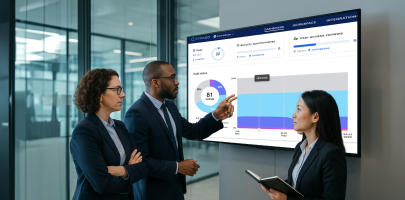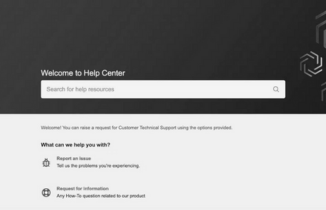Each compliance officer will admit to a scenario like this one: sitting in front of a laptop in the early morning hours with the glow of the screen illuminating their tired eyes as they sift through spreadsheets. Accountants will readily nod in sympathy. A recent thread on Reddit’s r/accounting brought collective agreement to this universal truth among CPAs: “If I open your Excel file and I have to manually turn on gridlines, then enable the formula bar, and you’ve somehow set Page Break Preview as the default view… I’m already 30% more annoyed before I even look at your work.”
This goes beyond the simple question of style; it’s a symptom of the compliance industry still relying on tools that are outdated. While other business functions have adopted digital transformation, compliance teams remain stuck in a cycle of manual processes that drain resources, increase risk, and burn out talented professionals.
The price isn’t just irritation, it’s a real influence on organizational health. Organizations lose hundreds of thousands of dollars annually from their spreadsheets and related errors. But there’s a better way.
The Spreadsheet Trap: How Compliance Teams Get Stuck
Progress toward spreadsheet dependence is not as direct or as immediate as one might expect. Making the shift from relying on spreadsheets to other modes of sharing and recording information occurs quite a bit more slowly than it should. This is partly because it happens in steps, with each spreadsheet begetting another, and spreadsheets can become so complex and integral that they can only be extirpated at great cost.
Think about what makes up that compliance team. It’s not just bad spreadsheets; it’s what lives in bad spreadsheets. The average compliance department keeps its risk assessments, control testing, vendor reviews, incident tracking, audit evidence, and all its associated remediation plans in half a dozen other types of unreadable, unworkable toolkits that are all supposed to make good on the promise of ‘GRC’ (governance, risk, and compliance).
Version control becomes a nightmare. A centralized system for managing electronic records is something essential yet elusive for companies like the healthcare staffing company that recently shared on Reddit: “We keep getting hit with penalties, and it’s slowing down the speed of our business.” The culprit? Manual compliance tracking across multiple states with no centralized system to manage the complexity.
Human error is inevitable. The European Spreadsheet Risk Interest Group reports that mistakes are prevalent in over 90% of spreadsheets, resulting in an average error rate of 3.9% within individual cells. In contexts where companies must adhere to a range of laws, these can be extremely costly because spreadsheets are where personnel put the details together, forming the substantiation of what led to a particular decision.
Working in compliance can carry an emotional burden. I certainly didn’t get into this field to become a glorified data entry professional, but that’s often what it feels like in job after job. Most compliance professionals spend upwards of 60% (oftentimes 70%) of their time on administrative tasks.
Why Compliance Tracking Software Beats Excel Every Time
Contemporary software for compliance tracking alters a former manual nightmare into an automated and audit-ready process. In contrast to static spreadsheets, these instruments now give any organization using them a much clearer picture of just what their words in a policy mean—right at this very moment.
Real-time dashboards replace outdated reports. Stakeholders do not need to wait for someone to update the monthly compliance report; they have access to the current metrics at any time—24/7 if they wish. The testing for a failed control does not have to wait for the next quarterly, or even for a monthly, review; stakeholders are immediately informed whenever a control fails.
Automated audit trails eliminate manual documentation. Every step—be it of the control evaluation or the act of making up for a glitch—is documented with time and with whom. That isn’t just plain neatness or for show; it’s evidence that auditors can trust and regulators expect. According to Gartner’s research on GRC tools, organizations struggle with vendor evaluation processes taking over six months, largely due to the complexity of replacing manual systems.
Collaborative workflows replace email chaos. Recall the most recent instance when you attempted to gather audit evidence using email coordination. Automated compliance workflows assign tasks, track progress, and maintain accountability without the endless email threads that plague spreadsheet-based processes.
Switching is entirely justified when you look at the integration capabilities. They connect directly with what’s already in your tech stack—from HR systems for employee onboarding compliance to cloud infrastructure for security control monitoring. This integration eliminates the manual data shuttling that consumes so much compliance team bandwidth.
The True Cost of Manual Compliance Management Tools
The spread of spreadsheet-based compliance costs money well beyond the apparent direct expense of labor. Hidden expenses accumulate across multiple dimensions:
Labor inefficiency creates massive hidden costs. If your compliance team dedicates 40 hours each month to manual data collection and report creation, that forms a $50,000 annual expense for a single team member. Extend that over a 5-person team, and you’re looking at $250,000 in labor costs that rely on inefficiency and could otherwise be prevented through automation.
Audit delays translate into real losses. When auditors are left groping through unorganized information in search of evidence, they must add calendar time to the audit. And the more time they add, the higher the audit fee. One organization reduced their SOC 2 audit timeline from 16 weeks to 8 weeks simply by implementing automated evidence collection.
Regulatory penalties from missed deadlines are entirely preventable. Manual tracking makes it easy to miss submission deadlines or control testing schedules. A PwC study on spreadsheet errors found that most spreadsheets (nearly 92%) contain formulas or data that are not quite right; users assume their spreadsheets are correct, but over 90% of the time, they are not. Regulatory authorities can levy fines ranging from $50,000 to $500,000 when violations are discovered.
Opportunity costs multiply over time. Time spent not doing what we should be doing is time spent with poor governance, risk, and compliance (GRC) outcomes. Every hour spent on administrative compliance tasks is an hour not spent on strategic risk assessment, business process improvement, or professional development.
High turnover rates further exacerbate the issue. In the realm of compliance, when a team member moves on, they take with them invaluable experience that must be filled. The replacement cost for team members lost to burnout averages 50-200% of annual salary, not including knowledge transfer delays and interim coverage expenses.
How Compliance Automation Transforms Your Workflow
Compliance automation drastically rethinks compliance work from the ground up. Instead of using manually driven, reactive processes that kick in only when something’s gone wrong, it enables teams to implement forward-looking, intelligent, foolproof compliance workflows that prevent issues from becoming problems before they happen.
Uninterrupted automated evidence collection runs continuously. Contemporary platforms undertake this task with remarkable efficiency, organizing assorted “artifacts”—access reviews, signed policies, configurations, and much more—into tidy narratives that satisfy business activity metrics. They do it in such a continuous manner that during audit season, the auditor can simply review what the historical occurrences of business activity looked like thanks to all the artifacts churned out year-round.
Risk assessment becomes dynamic rather than static. Traditional assessments are too often a point-slice of the project as it stands on a particular day. Automated platforms, by contrast, integrate with a variety of systems to provide not just automation but real-time risk scoring based on current conditions. When a critical vendor experiences a security incident, your risk register updates automatically.
Control testing moves from being periodic to being continuous. Manual control testing used to happen once a quarter or once a year, but with automated testing, it can happen at any point. This enables immediate feedback to the control owner, system owner, and auditor when something changes in the controls.
McKinsey’s research on digital transformation identifies six main shifts in risk and compliance that allow companies to minimize problems when undergoing digital transformation. The transformation extends beyond efficiency to effectiveness, with intelligent compliance solutions leveraging artificial intelligence to identify patterns, predict risks, and recommend proactive measures.
Reporting becomes insights-driven. Rather than counting how many reports they’ve generated, compliance teams can turn their findings into strategic decisions and recommendations. Executive dashboards make what’s visible also insightful, enabling informed decision-making rather than reactive firefighting.
Making the Switch: From Spreadsheets to Smart Compliance Monitoring Software
Reforming compliance from spreadsheets to compliance monitoring software calls for strategic planning but yields almost immediate payoffs. Migrations tend to work best when they follow a proven methodology:
Initiate with a pilot framework. Your company’s most arduous requirement—be it SOC 2 or ISO 27001—serves as a suitable first testing ground. This is where you signal to your organization that you’re onto something useful. From here, you should feel comfortable expanding to additional frameworks—HIPAA, HITRUST, NIST, and so forth.
Data migration doesn’t need to be perfect. Many teams delay automation projects because they want to “clean up” their spreadsheets first. This goes-slow approach actually prolongs the timeframe for achieving improvements. Modern platforms can import “messy” data and help organize it through automated workflows.
Change management focuses on value, not features. Team members need to grasp how automating their work will improve their everyday work lives. According to NIST’s cybersecurity framework guidance, organizations should emphasize the shift from administrative work to strategic analysis that makes compliance careers more fulfilling.
Integration takes place in gradual steps. On the first day, you are not required to have total connection of all your systems. Start with what is fundamental—typically directory services and key business applications—then expand connectivity over time based on demonstrated value.
Training becomes ongoing rather than one-time. These platforms are not at all like static spreadsheets. They evolve steadily, with ongoing regular appearance of new functionality. Build training into regular team routines rather than treating it as a project deliverable.
Research from financial institutions shows that process automation achieves an average ROI of 250% within two years, with automated compliance solutions reducing manual oversight errors by up to 70%.
Future-Proofing Your GRC Tools Strategy
The pace of evolution in the compliance landscape is quickening. Compliance teams are under unremitting regulatory pressure, with new mandates arriving from multiple directions. GRC tools that seemed adequate five years ago struggle with today’s requirements.
Regulatory complexity continues increasing. The start was the General Data Protection Regulation (GDPR), which came into effect in the European Union in 2018. Since then, privacy legislation has proliferated in the United States. This means organizations face a patchwork of requirements that manual processes simply cannot manage effectively. GDPR compliance tools that automate privacy impact assessments and data mapping become essential for multi-jurisdictional organizations.
Cloud-first architectures demand new approaches. Traditional compliance frameworks were designed for yesterday’s infrastructure where application and corporate data sat within well-defined network perimeters. Modern organizations operate in hybrid and multi-cloud environments where assets are distributed across multiple providers and regions. Scalable GRC tools must adapt to this architectural reality.
Artificial intelligence creates both opportunities and risks. Tools that use artificial intelligence can automate intricate judgments human assessors once made. However, AI-powered compliance tools also introduce new categories of compliance requirements around algorithmic bias, data usage, and automated decision-making. Gartner’s research on DevOps continuous compliance automation shows organizations are increasingly adopting tools to assess and report against a growing number of compliance requirements.
Integration capabilities become competitive advantages. Organizations that can smoothly link compliance information with business operations form faster, better decisions about risk. This integration necessity will grow sharper as business velocity intensifies.
Continuous compliance becomes the standard. Annual audits and quarterly assessments are giving way to continuous monitoring and real-time compliance verification. Organizations that maintain continuous compliance readiness can respond more quickly to business opportunities and regulatory changes.
Stop Drowning, Start Swimming
We are reaching the end of the spreadsheet compliance era. There are big disadvantages for organizations that still rely on manual methods when regulatory requirements are doing everything but getting simpler, and when today’s businesses operate in an ever more complex environment.
The solution isn’t just about tools—it’s about a fundamental shift in perspective, from compliance to risk navigation. Modern compliance automation platforms don’t just replace spreadsheets; they enable compliance professionals to become strategic advisors who help organizations navigate risk intelligently.
Your compliance team merits more than drowning in spreadsheets. They merit tools that enhance their expertise rather than obscure it in routine administrative tasks. The issue is not whether we should automate; that’s a foregone conclusion. The real challenge is seeing how quickly we can make this transformation our new reality.
Ready to see how automated compliance transforms your team’s effectiveness? Explore how Cypago’s compliance automation platform can eliminate your spreadsheet dependency and elevate your compliance program to meet tomorrow’s challenges.
Contact us >






